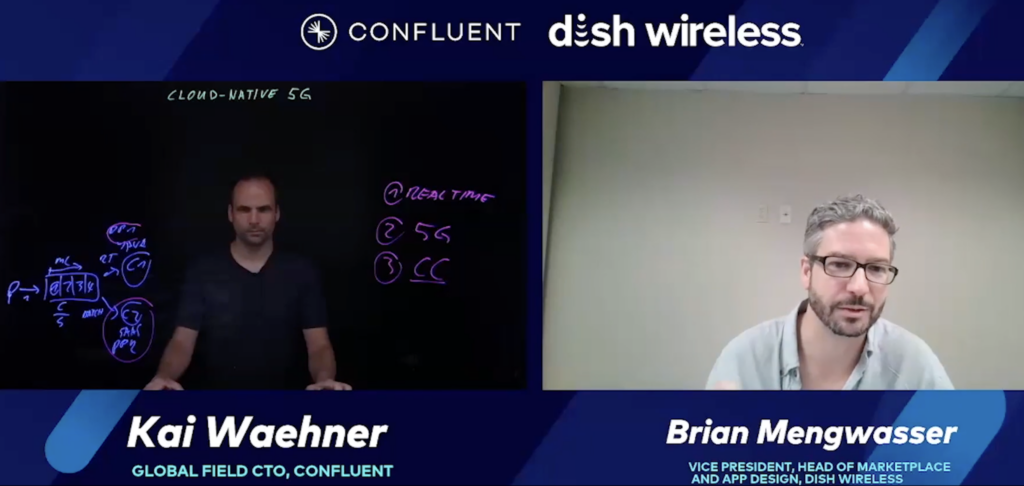5G telco infrastructure provides the basic foundations of data movement and increasingly unlocks new capabilities for low latency and critical SLAs. Real-time data processing with data streaming using Apache Kafka enables innovation across industries. This blog post explores the success story of Dish Wireless and its cloud-native standalone 5G infrastructure leveraging data streaming. The service provider enables enterprises to think in a new, innovative way about telco networks to build the next generation of applications for more efficient supply chains and better customer experiences.
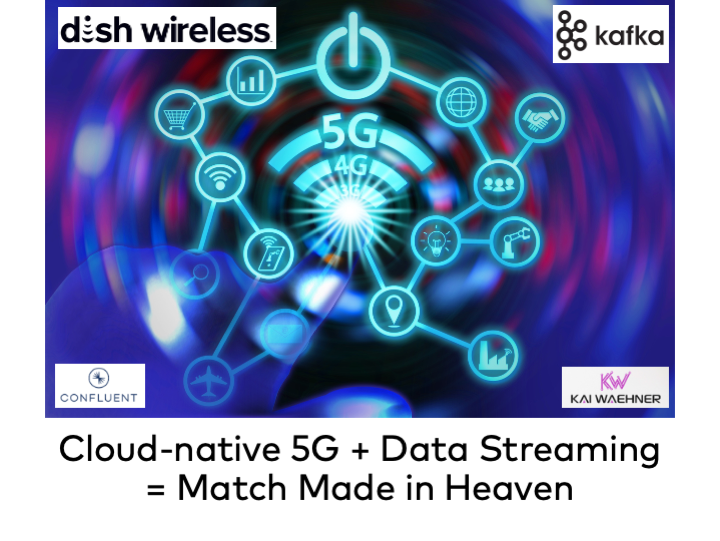
What is a 5G telco network?
5G, short for “fifth generation,” is the latest generation of wireless communication technology for mobile devices and networks. It represents a significant advancement over its predecessor, 4G LTE (fourth generation).
Technical benefits of 5G
Here are some key features and characteristics of 5G:
- Faster speeds: 5G offers significantly faster data transfer speeds than 4G. It delivers download speeds of up to several gigabits per second, allowing for nearly instantaneous downloads of large files, high-definition video streaming, and low-latency online gaming.
- Low latency: One of the most notable improvements in 5G is its low latency, which refers to the delay between sending and receiving data. This low latency is crucial for applications like autonomous vehicles, remote surgery, and real-time augmented and virtual reality experiences.
- Increased capacity: 5G networks can support a much larger number of devices simultaneously within the same geographic area. This is essential for the growing number of connected devices in the Internet of Things (IoT) ecosystem.
- Enhanced connectivity: 5G networks use a variety of frequency bands, including higher-frequency millimeter-wave (mmWave) bands and mid-band frequencies. These higher frequencies enable faster speeds but require more infrastructure, including small cells and antennas placed closer together.
- Improved network slicing: 5G allows for network slicing, which means network operators can allocate specific portions of the network to meet the needs of different applications and services. This enhances the flexibility and efficiency of the network.
- Security: Cellular has advantages in authentication, ruggedization, and built-in systematic threat detection/mitigation versus other commonly used networks (Wi-Fi, LPWAN, etc.). 5G was completely redesigned vs. 4G to adopt a zero-trust paradigm, including within the network and additional features that protect user identity. In contrast to a monolithic “trusted telco” network, 5G more closely aligns with the best practices of the most sophisticated enterprise networks.
Business opportunities of 5G
5G enables a massive potential for New Applications across all industries. 5G technology opens the door to various innovative applications and services. It can revolutionize entire industries, like healthcare, transportation, and entertainment.
Here are a few concrete examples:
- Intelligent infrastructure: Deploying 5G infrastructure to enable smart city applications, such as traffic management, environmental monitoring, and public safety.
- Connected and autonomous vehicles (CAVs): Building and providing connectivity solutions for autonomous cars, drones, and other autonomous vehicles that rely on low-latency 5G networks.
- Factory automation: Implementing 5G for real-time monitoring and control industrial processes in smart factories.
- Supply chain optimization: Using 5G for visibility, tracking, and management.
- Enhanced retail customer experience: Leveraging 5G for augmented reality shopping experiences, cashless stores, and personalized marketing.
- Inventory management: Implementing real-time inventory tracking and management using 5G-connected sensors.
- Cloud gaming: Launching cloud gaming platforms that leverage 5G’s low latency and high bandwidth for streaming games.
- Augmented and Virtual Reality (AR/VR): Developing immersive AR and VR experiences enabled for a new entertainment.
- And so much more…
Overall, 5G represents a significant leap forward in wireless technology. 5G offers faster speeds, lower latency, and improved connectivity to support the increasing demands of our increasingly connected world.
Dish Wireless Standalone 5G infrastructure
“Dish Wireless” refers to the wireless division of Dish Network Corporation, a company primarily known for providing satellite television services in the United States. It is Dish Network’s venture into the wireless telecommunications industry.
The marketing slogan is “The DISH 5G Open RAN network is flexible, scalable and transparent. With DISH Wireless, the only limit is your imagination.” I love it because it is true! The infrastructure is cloud-native, and data streaming is a core piece of it.
Here are some key points about Dish Wireless:
- Entry into wireless: Dish Network acquired a substantial amount of wireless spectrum through various acquisitions, including assets from bankrupt companies like Clearwire and Sprint, to enter the wireless market.
- 5G network deployment: Dish Wireless has been working on building its own 5G wireless network, aiming to compete with other major wireless carriers in the United States. This network is being developed using 5G technology and provides broadband internet and mobile services.
- Building infrastructure: To build its 5G network, Dish Wireless has invested in infrastructure development, including cell towers, small cell sites (coming soon), and other network components. They are working to deploy a nationwide network gradually. When writing this article in September 2023, Dish Wireless already covers >73% of the US population!
- Wireless services: Dish Wireless offers a range of wireless services, including mobile phone plans, home internet services, and potentially other IoT (Internet of Things) services.
Dish Wireless 5G from a technical perspective
The Dish infrastructure innovates in many ways compared to most other telco networks operating today:
- OpenRAN: Built on open standard interfaces between all telco components. Allows Dish Wireless to mix and match vendor software and radios.
- Virtualization: The entire infrastructure is built on commodity x86 hardware. This provides flexibility and compatibility across many vendors, such as AWS or VMware.
- Cloud-native: Containerized software, CI/CD style deployment, open observability (key for data generation), chaos testing, etc. These are “firsts” for 5G at scale deployment and revolutionary and might be a turning point in the entire global telco industry.
Data streaming with Apache Kafka in the telco industry
The evolution of telco infrastructure, customer services, and new business models requires real-time end-to-end visibility, fancy mobile apps, and integration with pioneering technologies like 5G for low latency or augmented reality for innovation.
Many enterprises in the telecom sector leverage data streaming with Apache Kafka in various use cases across OSS, BSS, and OTT services.
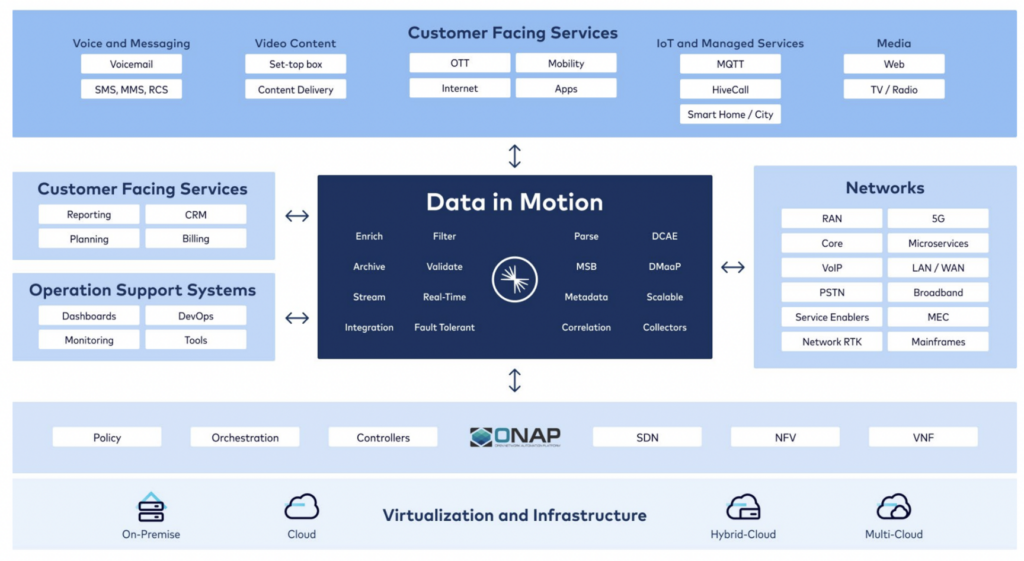
Learn about trends, architectures, and customer stories from Dish Network, British Telecom, Globe Telecom, Swisscom, and more in the blog post “The State of Data Streaming for Telco in 2023“.
And here is a blog and video recording about Cloud-Native 5G, MEC and OSS/BSS/OTT Telco with Apache Kafka and Kubernetes.
This post specifically looks at the usage of data streaming at Dish Wireless.
How Dish leverages data streaming powered by Apache Kafka for 5G infrastructure
Brian Mengwasser (Vice President, Head of Marketplace and App Design at DISH Wireless) explored the general strategy, technical architecture, and opportunities for customers of Dish Wireless 5G products. You can find the on-demand recording below.
Dish Wireless cloud-native 5G network
Dish Wireless had the benefit (and challenge) of starting from scratch. The entire 5G infrastructure is cloud-native and provides elastic scalability.
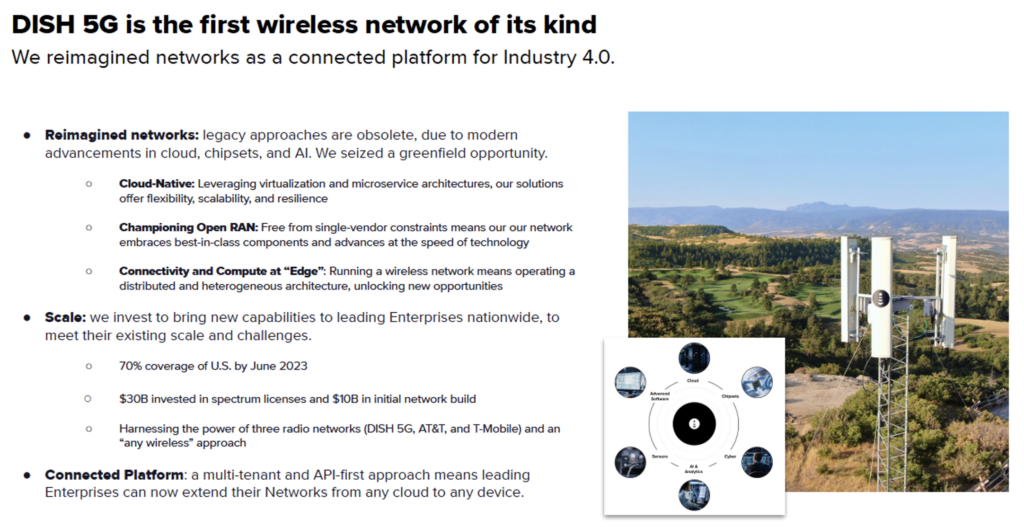
Dish Wireless connectivity platform
The Dish Wireless connectivity platform enables real-time communication from any cloud to any device:
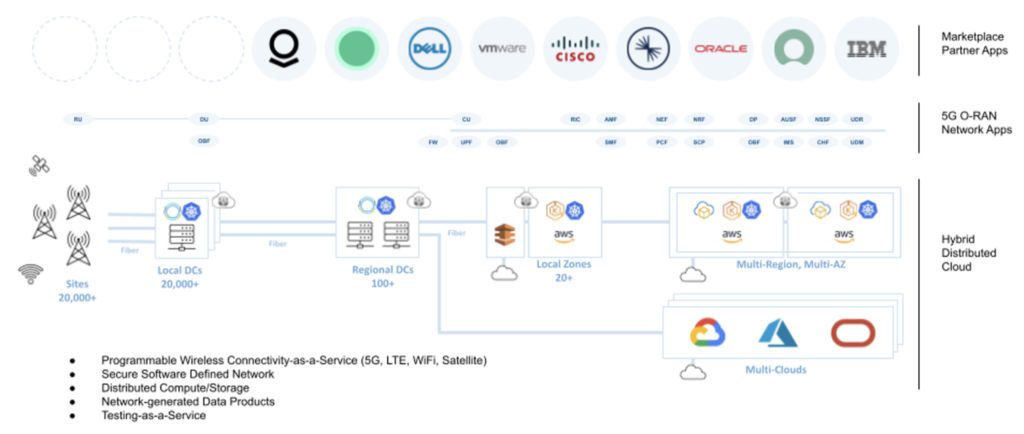
As you can see, the 5G infrastructure requires the combination of many critical software and hardware vendors. AWS, IBM, Dell, VMware, Oracle, and Confluent.
Dish Wireless data platform powered by 5G and Apache Kafka
The enterprise architecture of the Dish Wireless data platform enables the building of decoupled data products. The network stack comprises various components like RAN Core applications, traffic inspection, and observability platforms. The data-driven applications include data engines, service orchestrators, correlation tools, and integration with 3rd party interfaces.
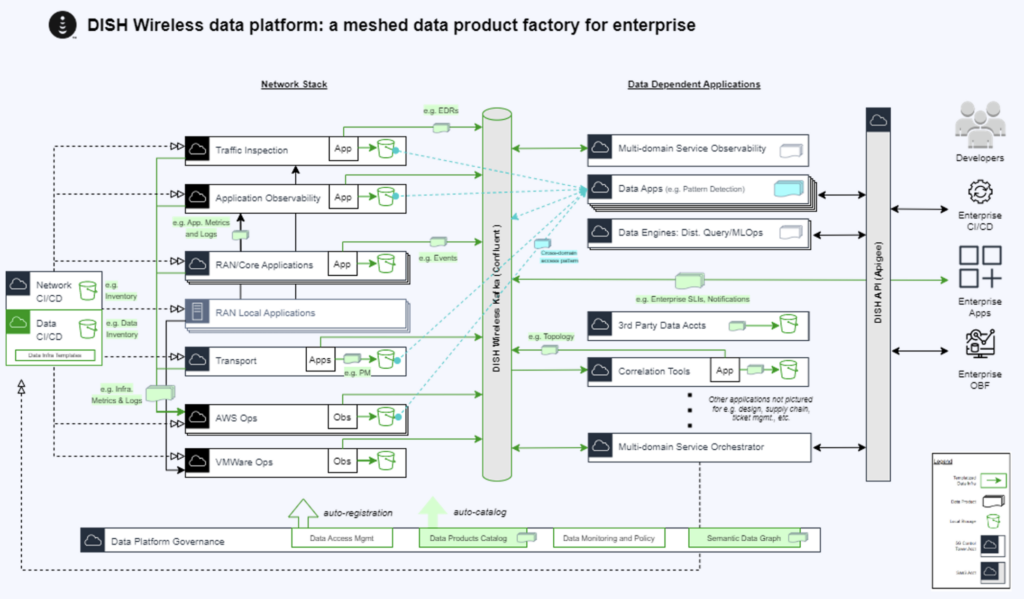
The central nervous system of the enterprise architecture is the data streaming platform Confluent. It collects from various data sources, processes and correlates real-time and historical data, and shares information with downstream applications like mobile apps, data lakes, and data warehouses.
How to innovate with real-time use cases combining 5G networking and Apache Kafka
5G is an innovative technology that allows building new real-time applications not possible before. However, infrastructure alone does not solve the problem. Software is needed on top of the infrastructure. Therefore, 5G and data streaming are a match made in heaven. Both support real-time data processing at an elastic scale.
Let’s look at a few examples of combining 5G and data streaming with Apache Kafka.
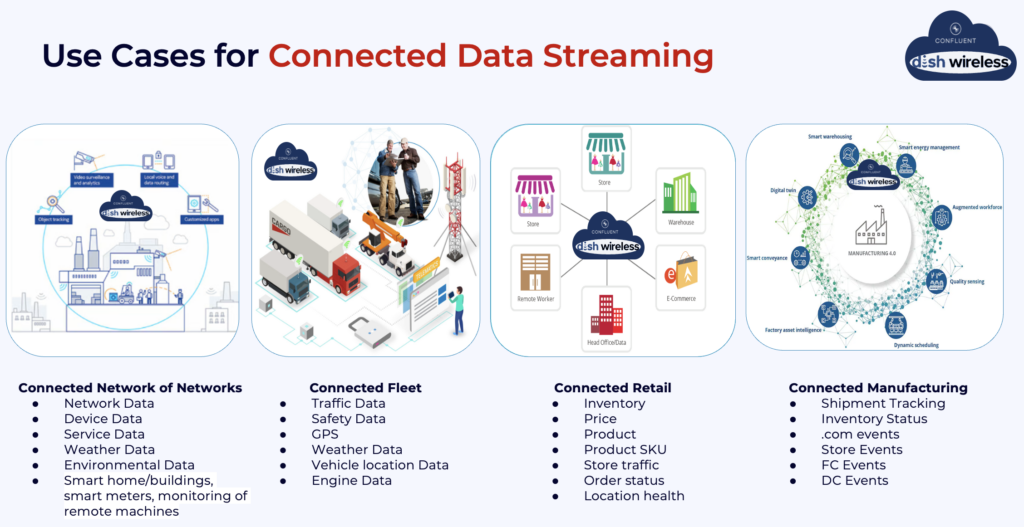
Connected data streaming in retail
The retail industry has many use cases that can leverage 5G infrastructure and Apache Kafka for logistics, point of sale, and location-based customer services.
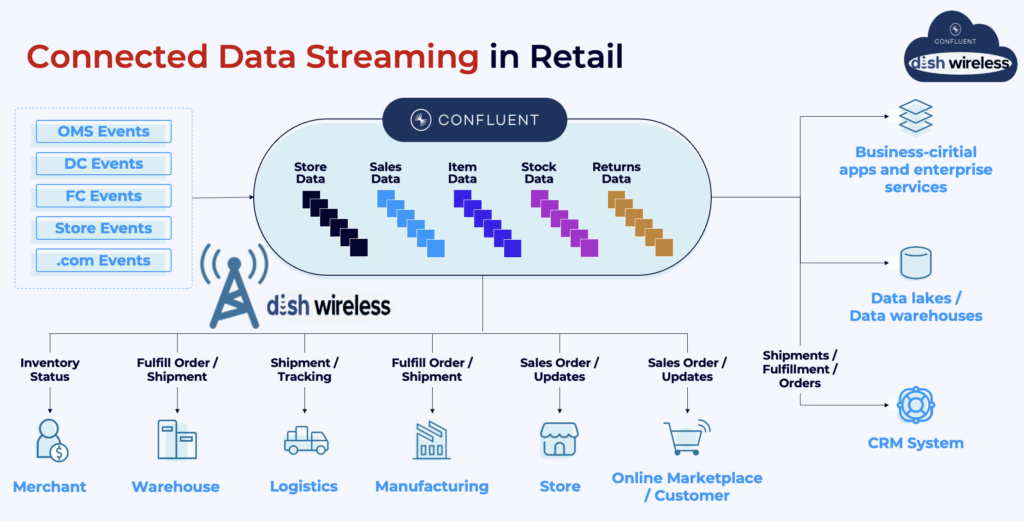
The state of data streaming for retail in 2023 explores the art of the possible. Use cases include omnichannel customer experiences, hybrid shopping models, and hyper-personalized recommendations. Data streaming allows integrating and correlating data in real-time at any scale. I explore customer stories from Walmart, Albertsons, Otto, AO.com, and more,
Connected data streaming in manufacturing
Manufacturing requires real-time information and data consistency across the entire supply chain, including shop floor, supplier integration, intralogistics, interlogistics, and customer-facing aftersales and service. Apache Kafka and 5G help to build hybrid edge deployments:
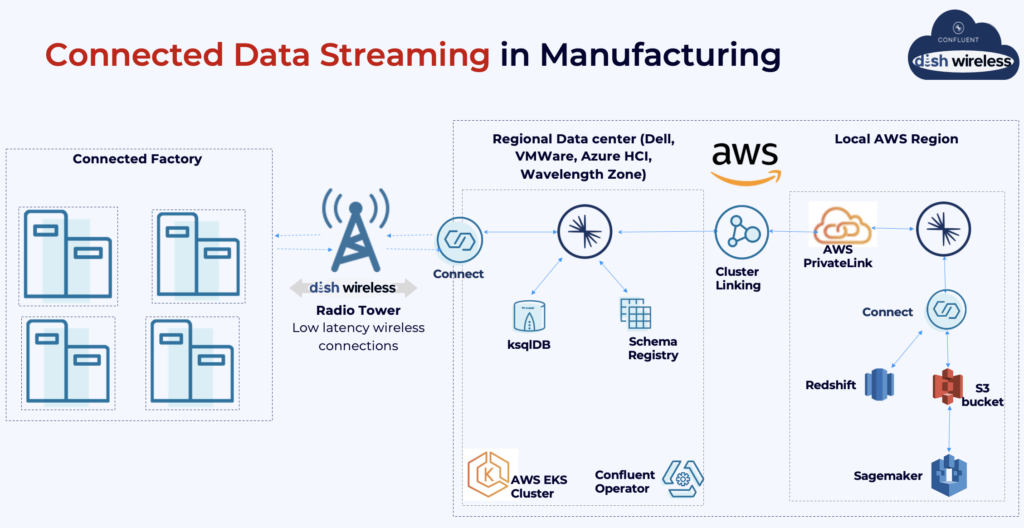
The state of data streaming for manufacturing in 2023 explores the evolution of industrial IoT, manufacturing 4.0, and digitalized B2B and customer relations. Most use cases require modern, open, and scalable information sharing. The foci are trending enterprise architectures in the manufacturing industry and data streaming customer stories from BMW, Mercedes, Michelin, or Siemens.
Connected data streaming in automotive
The automotive industry requires B2B integration with suppliers, OT/IT integration from the shop floor to the cloud, and innovative customer-facing apps like mobility services. Many of these challenges can only be solved by combining low-latency networking and real-time data processing at scale with 5G and Apache Kafka.
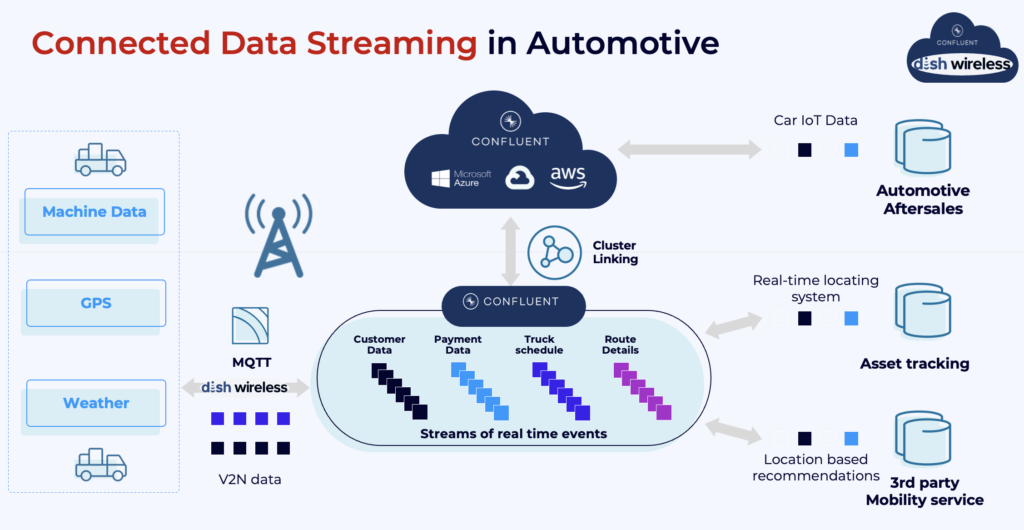
Real-World Deployments of Kafka in the Automotive Industry explores various real-world deployments across several fields. Use cases include connected vehicles, smart manufacturing, and innovative mobility services. Case studies cover car makers such as Audi, BMW, Porsche, and Tesla, plus a few mobility services such as Uber, Lyft, and Here Technologies.
On-demand video: 5G and data streaming @ Dish Wireless
Here is the recording of an interactive discussion and presentation I gave together with Brian Mengwasser (Vice President, Head of Marketplace and App Design at DISH Wireless):
If you just want to see the high level story, watch the following 3min summary on YouTube exploring how Dish Wireless leverages Apache Kafka and Confluent Cloud in their 5G infrastructure:
Telco panel: From Telco to TechCo
If you want to learn more from other telco experts, here is an on-demand panel where I discuss the evolution of data streaming in the telecom sector with peers from several organizations: “How Telcos are Shaping the Future of Communication with Data Streaming“:
- Proximus (Service Provider): Antonietta Mastroianni, Telco Woman of the Year
- Telefónica (Service Provider): Mariam Kaynia, VP Mass Market
- Deloitte (System Integrator): Enterprise Architect and Telco expert Philip Parker
- TM Forum (Non-Profit Organization): Andy Tiller, Executive Vice President, Products & Services
5G and data streaming are a match made in heaven
Real-time data beats slow data. That’s true for almost every use case. Specifically, most innovative use cases in the telco industry require real-time accurate information, regardless of the scale. No matter if you build internal applications to monitor the networks or external new services for logistics, transportation, retail, or any other industry.
5G infrastructure provides low latency with critical SLAs (thanks to network slicing capabilities). Data streaming with Apache Kafka provides features for collecting, storing, processing, and sharing events. The combination of 5G and data streaming enables innovation, where the only limit is your imagination.
How do you use or plan to use 5G networks together with data to innovate? Let’s connect on LinkedIn and discuss it! Join the data streaming community and stay informed about new blog posts by subscribing to my newsletter.

